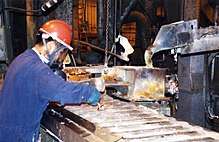Occupational toxicology
Occupational (or industrial) toxicology is the application of the principles and methodology of toxicology to understanding and managing chemical and biological hazards encountered at work. The objective of the occupational toxicologist is to prevent adverse health effects in workers that arise from exposures in their work environment.[1]
The science of toxicology has many applications. One of these, relates to exposure of people to noxious or hazardous agents during the course of their work. Field of occupational toxicology is the study of the adverse effects of agents that may be encountered by.workers during the course of their employment.[2]

The work environment has played a significant role in the occurrence of adverse human health effects due to chemical and biological hazards for centuries. Occupational health specialists, including toxicologists, rely upon human and animal data to determine safe exposure levels. If effects observed in workers can be reproduced in a laboratory animal, it becomes possible to investigate the mechanisms that might reasonably be expected to produce such effects. On the other hand, shedding light on the mechanism by which a designated effect is produced in a test animal species may make it easier to find ways to prevent such effects from occurring in humans. Such an understanding may also help to identify subtle or delayed effects that have not been observed in workers, but to which health professionals should be alerted.[4]
Exposure
Occupational exposures involve situations ranging، for example from a secretary using typewriter correction fluid to the loading and off-loading of tanker trucks with thousands of gallons of gasoline.
History
Early writings by Ulrich Ellenbog (1435–1499), Agricola (1494–1555), and Paracelsus (1492–1541) revealed the toxic nature of exposures in mining, smelting, and metallurgy. A systematic treatise by Ramazzini (1633–1714) described the hazards as they applied to miners, chemists, metal workers, tanners, pharmacists, grain sifters, stonecutters, sewage workers, and even corpse bearers.[1]
How is occupational toxicology used?
- Role in decision making within hierarchical control
- Role in setting exposure standards for workplace chemicals
- Role in biological monitoring for chemical exposure[2]
Biological monitoring
The measurement of a chemical, its metabolite, or a biochemical effect in a biologic specimen for the purpose of assessing exposure. Biologic monitoring is an important tool to identify the nature and amount of chemical exposures in occupational and environmental situations.[5]
Heavy metals
Metals with a density of more than 5 g/cm3 and toxic effects. Including arsenic, cobalt, lead, lithium, mercury, and thorium, have documented ototoxic potential. The metals represent a different aspect of toxicology in that they do not undergo breakdown to other metals (to do so would be transmutation of the elements, an old alchemical principle still not possible without huge sources of energy, and a particle accelerator!). The absorption, disposition and excretion of metals are largely dependent on physical factors, such as solubility, ionisation, particle size and chemical species (for metal salts). About 70–80 elements in the periodic table are considered metals. Groups Ia and IIa, the‘s block’ metals, form monovalent and divalent cations respectively. Groups IIIb to VIb constitute the ‘p block’ elements, which include metals that can have ions of different valencies. These are called the transition elements. Of the metal elements, about 40 are considered to be ‘common’ metals. However, less than 30 have compounds that have been reported to produce toxicity. Metals are probably some of the oldest toxicants known to humans. Health effects such as colic were reported following exposure to lead, arsenic and mercury over 2000 years ago. On the other hand, metals such as cadmium, chromium and nickel belong to the modern era. The importance of some of the rarer metals may become apparent with emerging changes in technology, such as microelectronics and superconductors. The toxicity of a metal is only partially related to its position in the periodic table. Toxicity decreases with the stability of the configuration of electrons in the atomic nuclei. This produces a number of properties that can affect toxicity[6].
References
- 1 2 Casarett and Doull’s ,TOXICOLOGY, The Basic Science of Poisons
- 1 2 Occupational Toxicolog, 2nd EDITION, Edited by Chris Winder and Neill Stacey
- ↑ Brodkin, E; Copes, R; Mattman, A; Kennedy, J; Kling, R; Yassi, A (2007). "Lead and mercury exposures: interpretation and action". Canadian Medical Association Journal. 176 (1): 59–63. doi:10.1503/cmaj.060790. PMC 1764574. PMID 17200393.
- ↑ PRINCIPLES OF TOXICOLOGY , Environmental and Industrial Applications , SECOND EDITION , Edited by Phillip L. Williams,
- ↑ CURRENT Occupational & Environmental Medicine,fourth edition Edited by Joseph LaDou
- ↑ Occupational Toxicolog, 2nd EDITION, Edited by Chris Winder and Neill Stacey
